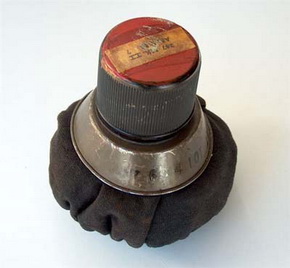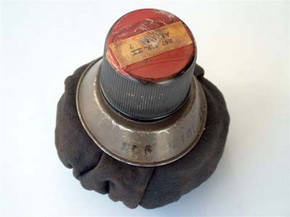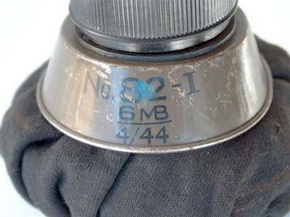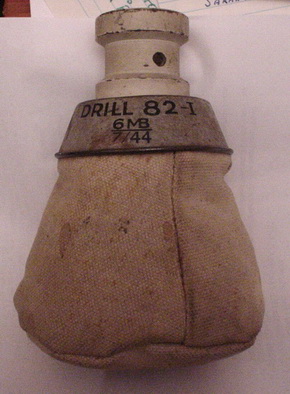|
|
| BRITISH EXPLOSIVE ORDNANCE |
| Part 5 - Chapter 2 |
| Anti-Personnel Grenades |
|
A./P. Hand Grenade No. 82 Mk I (Service) |
| Data |
|
Total weight |
2 lb. approx. |
|
Filling |
Plastic explosive |
|
Filling weight |
1 lb. approx. |
|
Fuzing |
No. 247 Mk I, II, or III, with short 4½ in. tape |
|
Delay |
None |
|
Color |
Fuze, black; cup, buff; bag, black |
|
Markings |
Standard |
|
Description: The body of this H.E. grenade, formerly known as the "Gammon Bomb", consists of a fabric bag, open at each end. The lower end of the bag is gathered, and an elastic band inserted around the edge, while the upper end fits under a steel cup. The edge is clamped between the cup and the flange of a tinned plate fuze housing by four equally spaced rivets. A tin-plate cap, to the lower end of which is secured an aluminum primer tube, is screwed over the fuze housing. |
|
The grenade is fuzed with the Fuze No. 247 wound with 4½ in. of tape instead of the usual 12 in. The primer tube contains a C.E. pellet over which is placed a felt washer. A central perforation in the pellet accommodates a Detonator No. 78 Mk I with a felt disc inserted between it and the bottom of the primer tube. |
|
The grenade is issued with the bag empty. The charge of plastic explosive is inserted through the bottom of the bag under local arrangements. |
|
Operation: First the grenade is primed and the plastic explosive inserted. The adhe-sive tape is then removed and the safety cap unscrewed, in one-half of a turn. After the cap is removed, the tape must be held in place by the forefinger and thumb. When thrown, the weight on the end of the tape causes the tape to unwind and pull out the safety pin. Only the creep spring is now holding the striker away from the primer cap. On impact, the striker is forced into the primer cap, initiates the delay which initiates the detonator and explodes the grenade. |
|
Remark: The No. 82 Mk I/I differs from the No. 82A Mk I in that it has a rot-proof fabric bag. |
|
This grenade has a general anti-personnel application, but is used mainly by airborne forces as an anti-tank weapon. |
|
|
| Figure 235 – A./P. Hand Grenade No. 82 Mk I |
 |
 |
 |
 |
|
Hand Grenade No. 82 Mk I – Drill |
|
|